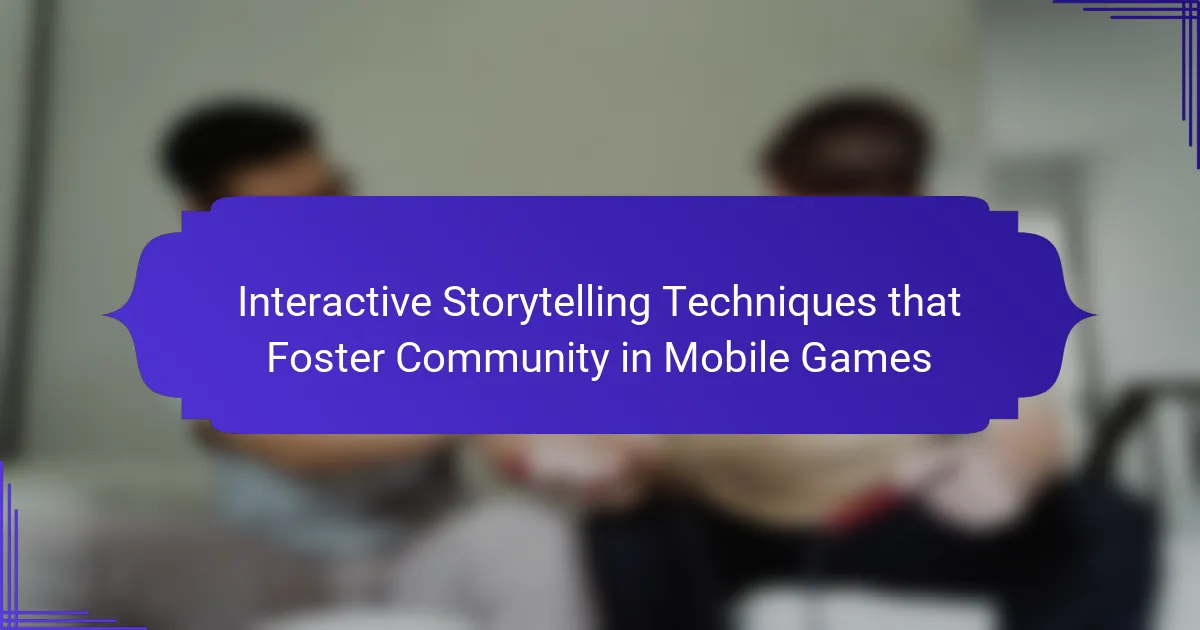Interactive storytelling techniques enhance community engagement in mobile games by promoting player interaction and collaboration. Key methods include branching narratives that impact story outcomes, community-driven content that allows user contributions, and real-time events that foster teamwork. Additionally, integrating social features facilitates communication, strengthening relationships among players. These elements create immersive experiences that deepen emotional connections and encourage shared narratives within the gaming community.
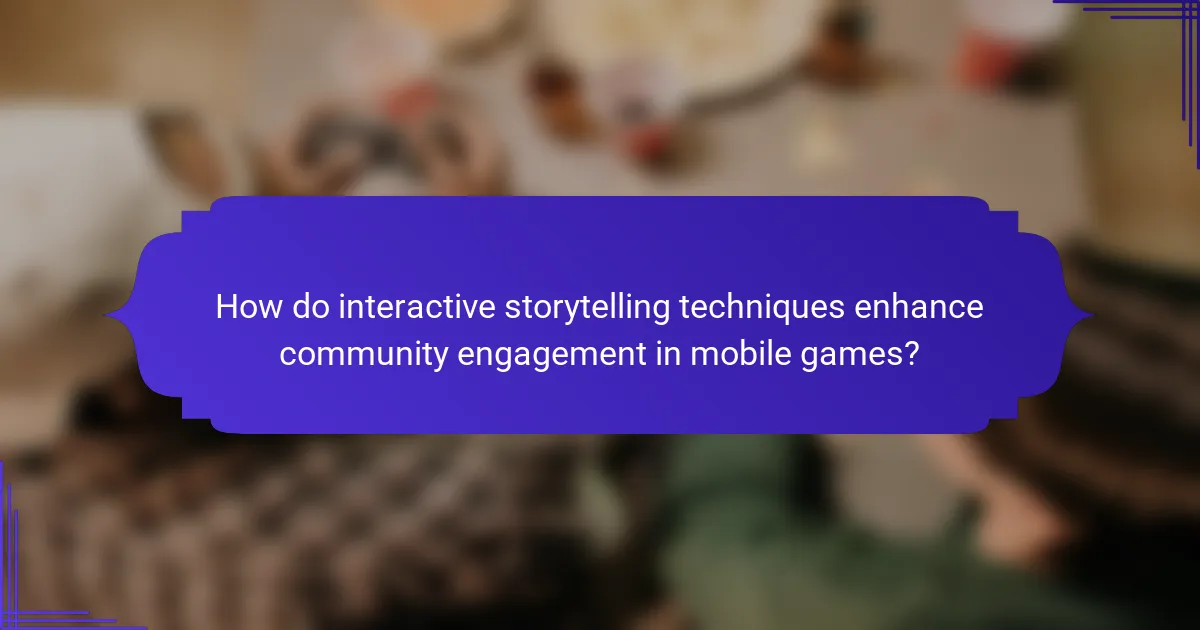
How do interactive storytelling techniques enhance community engagement in mobile games?
Interactive storytelling techniques significantly enhance community engagement in mobile games by fostering player interaction and collaboration. These techniques create immersive narratives that encourage players to share experiences and connect with others.
One effective method is branching narratives, where choices impact story outcomes. This approach promotes discussion among players about their unique experiences. Additionally, community-driven content, such as user-generated storylines, allows players to contribute, enriching the overall game environment.
Another technique is real-time events that require collective player participation. These events can lead to shared goals, enhancing teamwork and camaraderie. As a result, players feel a stronger sense of belonging within the gaming community.
Lastly, integrating social features, such as in-game chat or forums, facilitates communication. This connectivity fosters relationships, making players more invested in both the game and the community.
What role does player choice play in fostering connections?
Player choice significantly enhances connections in mobile games by allowing players to influence narratives and outcomes. This interactivity fosters a sense of ownership and investment in the game world. Players feel more engaged when their decisions impact storylines, leading to deeper emotional connections with characters and other players. Moreover, diverse choices promote community discussions, as players share experiences and strategies, enriching the overall gaming environment. This dynamic interaction exemplifies how player agency transforms solitary gameplay into a communal experience.
How can narrative-driven gameplay encourage collaboration among players?
Narrative-driven gameplay encourages collaboration by immersing players in shared stories. This shared experience fosters teamwork as players navigate challenges together, enhancing social bonds. Interactive storytelling techniques, such as branching narratives and character-driven quests, require players to communicate and strategize collectively. As a result, players feel invested in each other’s success, promoting a sense of community within mobile games.
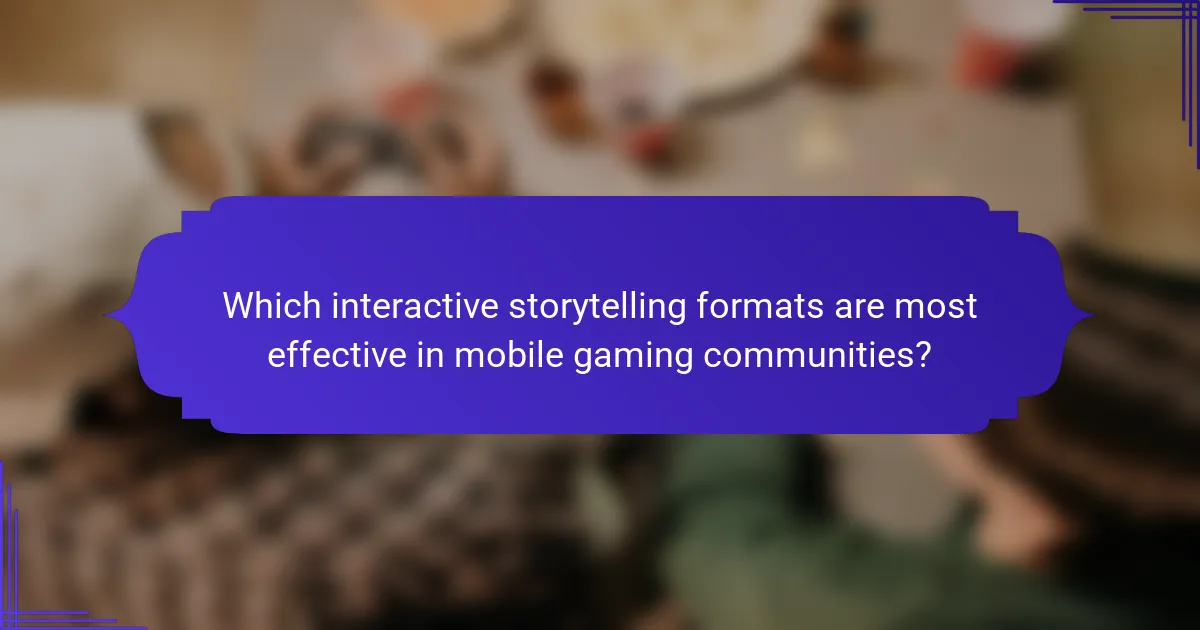
Which interactive storytelling formats are most effective in mobile gaming communities?
Interactive storytelling formats that engage mobile gaming communities include branching narratives, player-driven choices, and social storytelling features. These techniques enhance player investment and foster collaboration among users.
Branching narratives allow players to make decisions that influence the story’s outcome, creating a personalized experience. Player-driven choices enable users to shape the narrative direction, enhancing agency and emotional connection. Social storytelling features, such as community-driven quests or shared story arcs, encourage interaction and collaboration, strengthening community bonds.
These formats are effective because they promote engagement, increase replayability, and encourage user-generated content, leading to a vibrant gaming community.
What are the benefits of episodic storytelling in mobile games?
Episodic storytelling in mobile games enhances player engagement and fosters community. It creates anticipation for future episodes, encouraging discussions among players. This format allows for character development and emotional investment, making players feel connected. Additionally, episodic content can introduce unique attributes, such as limited-time events, which promote collaboration and competition within the community.
How do live events influence community interaction and storytelling?
Live events enhance community interaction and storytelling by creating shared experiences. They engage players, foster collaboration, and encourage real-time feedback. These dynamics build a sense of belonging and strengthen connections among participants. Interactive storytelling techniques in mobile games, such as live quests or community challenges, amplify narrative depth and player involvement. As a result, players contribute to evolving stories, making the gaming experience more immersive and socially enriching.

What psychological factors drive community building through storytelling in mobile games?
Interactive storytelling techniques in mobile games drive community building by fostering engagement, emotional connections, and shared experiences. These techniques include narrative choices, character development, and collaborative quests.
Narrative choices allow players to influence the story, creating a sense of ownership and investment. Emotional connections arise from relatable characters and story arcs, enhancing player attachment. Collaborative quests encourage teamwork, strengthening social bonds among players.
Incorporating these interactive storytelling elements cultivates a vibrant community, as players share their experiences and strategies. This shared narrative fosters discussions, leading to a deeper sense of belonging within the gaming environment.
How does emotional investment in characters foster community ties?
Emotional investment in characters enhances community ties by fostering empathy and shared experiences among players. This connection leads to stronger social interactions and collaboration within mobile games. Players often discuss character journeys, forming bonds over common narratives. Additionally, emotional stakes encourage players to support one another, creating a sense of belonging. This engagement ultimately strengthens the overall community, making it more vibrant and interconnected.
What impact does shared narrative experience have on player relationships?
Shared narrative experiences significantly enhance player relationships by fostering emotional connections and collaboration. These techniques create opportunities for players to engage in shared storytelling, building trust and camaraderie. As a result, players feel more invested in the game and each other, leading to stronger community bonds. Collaborative quests and interactive dialogues serve as unique attributes that deepen these relationships, allowing players to share their experiences and perspectives.
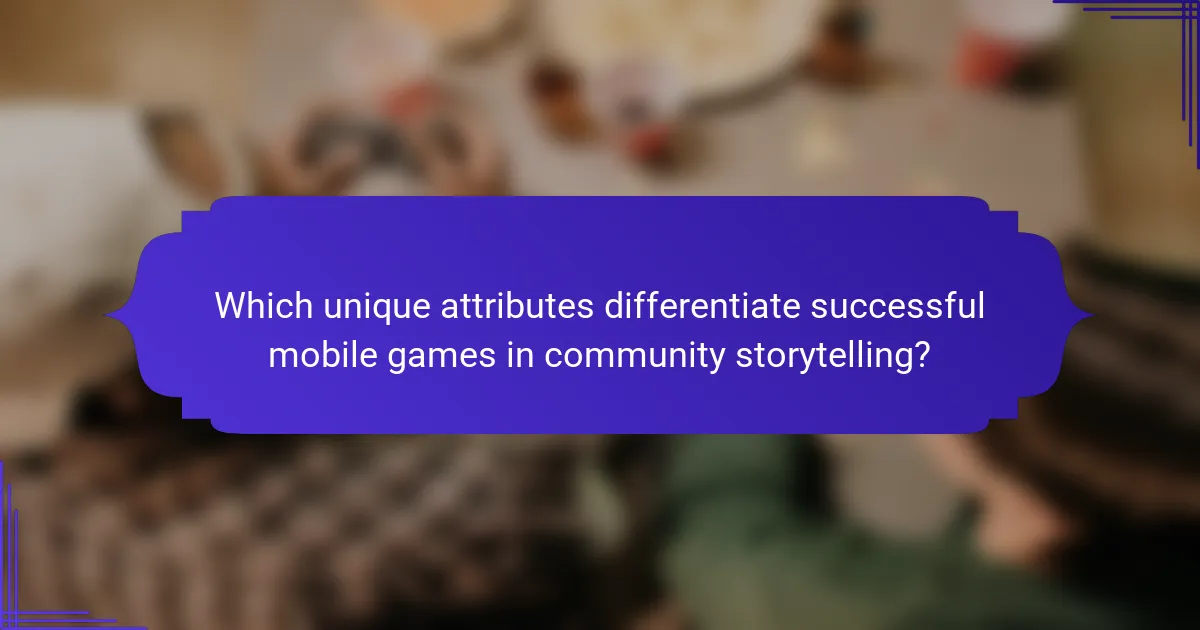
Which unique attributes differentiate successful mobile games in community storytelling?
Unique attributes that differentiate successful mobile games in community storytelling include player agency, emotional engagement, and collaborative narrative creation. Player agency allows users to make impactful choices, enhancing their investment in the story. Emotional engagement fosters connections through relatable characters and situations, increasing player retention. Collaborative narrative creation encourages community input, allowing players to contribute to the storyline, which strengthens social bonds. These attributes create immersive experiences that resonate with players, driving the success of mobile games.
How do cultural narratives enhance player connection in diverse communities?
Cultural narratives enhance player connection in diverse communities by fostering empathy and shared experiences. These narratives allow players to engage with characters and stories that reflect their cultural backgrounds, creating a sense of belonging. Through interactive storytelling techniques, games can incorporate unique cultural elements, promoting understanding and appreciation among players. This approach not only enriches the gaming experience but also strengthens community ties, facilitating collaboration and communication among players from different backgrounds.
What innovative features are emerging in mobile games to support storytelling?
Innovative features in mobile games increasingly support storytelling through interactive techniques that enhance community engagement. These features include player-driven narratives, where choices impact story outcomes, fostering a sense of ownership. Collaborative storytelling allows players to contribute to the plot, creating shared experiences. Live events and updates keep the community engaged by introducing new story elements and challenges. Additionally, social features enable players to discuss narratives and share experiences, strengthening community bonds. These attributes collectively enhance the storytelling experience in mobile games.
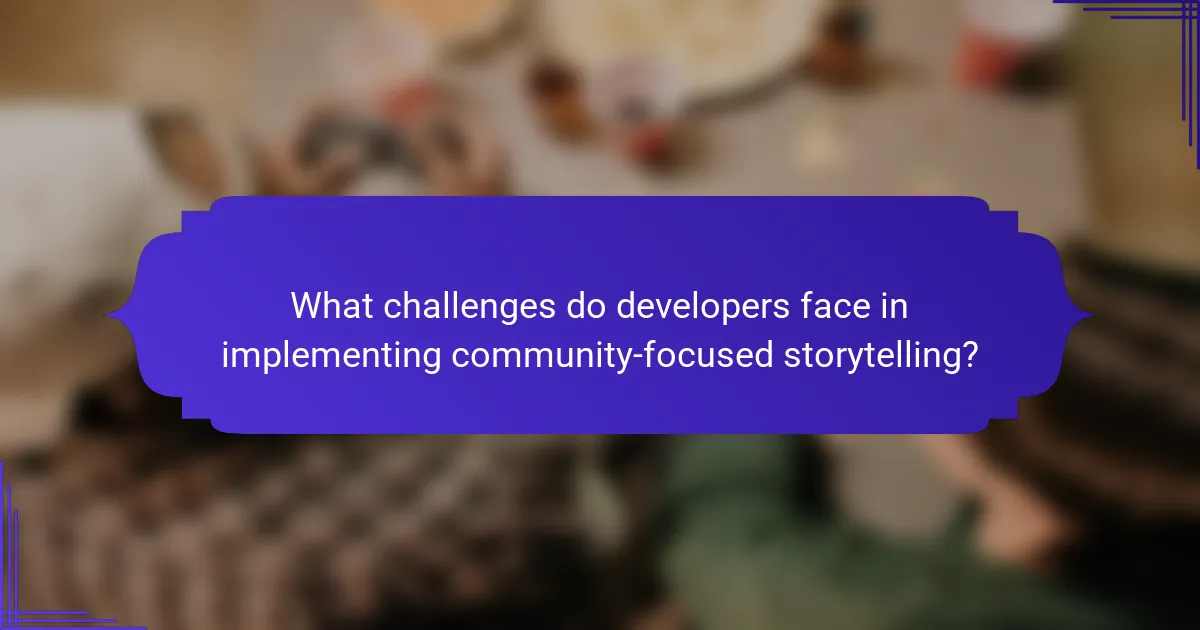
What challenges do developers face in implementing community-focused storytelling?
Developers face several challenges in implementing community-focused storytelling in mobile games. Key issues include balancing player agency with narrative direction, ensuring meaningful player interactions, and managing diverse player expectations.
Engaging players while maintaining a cohesive story can be difficult. Developers must create narratives that resonate with various community members, which requires extensive testing and feedback.
Technical constraints, such as performance limitations on mobile devices, can hinder the complexity of storytelling techniques. Developers often struggle to integrate rich narratives without sacrificing gameplay quality.
Finally, fostering a sense of community requires ongoing support and updates, which can strain development resources. Developers need to allocate time and personnel to nurture community interactions and story evolution.
How can balancing narrative depth and gameplay mechanics improve community engagement?
Balancing narrative depth and gameplay mechanics enhances community engagement by creating immersive experiences. Engaging stories motivate players to connect, while solid mechanics encourage interaction. These elements foster collaboration and communication among players, strengthening community bonds.
Interactive storytelling techniques, such as branching narratives and character development, allow players to influence outcomes. This personal investment increases emotional attachment, leading to richer community interactions. Additionally, mechanics like cooperative gameplay and shared challenges promote teamwork, further enhancing community engagement.
In mobile games, maintaining a balance between these aspects ensures players remain invested. Engaged players are more likely to participate in discussions, share experiences, and contribute to the game’s culture, ultimately benefiting the overall community.
What are common pitfalls in interactive storytelling that hinder community building?
Common pitfalls in interactive storytelling that hinder community building include lack of player agency, poor narrative coherence, and insufficient feedback mechanisms. These issues can alienate players and diminish engagement.
1. Lack of Player Agency: When players feel their choices do not impact the story, they disengage and feel less connected to the community.
2. Poor Narrative Coherence: Disjointed storytelling can confuse players, leading to frustration and reduced collaboration among community members.
3. Insufficient Feedback Mechanisms: Without proper feedback, players may not feel their contributions are valued, weakening community ties.
4. Overly Complex Mechanics: Complicated systems can deter participation, as players may feel overwhelmed and less inclined to engage with others.
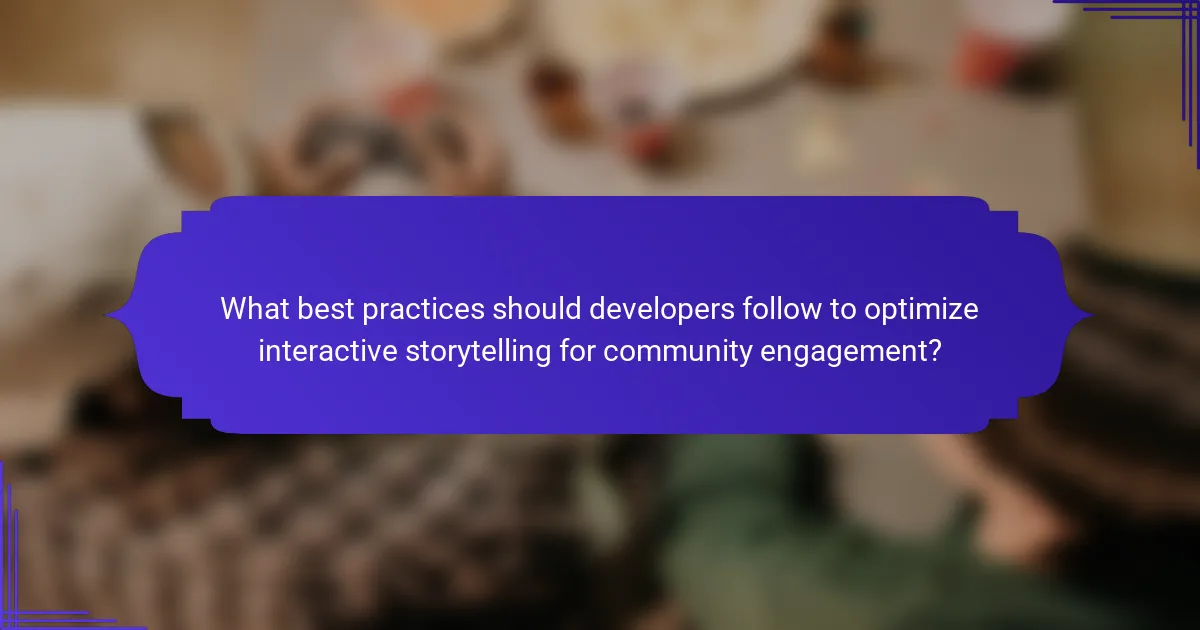
What best practices should developers follow to optimize interactive storytelling for community engagement?
Developers should prioritize user feedback, create collaborative narratives, and incorporate community-driven content to optimize interactive storytelling for engagement. These practices enhance player investment and foster a sense of belonging.
Encourage community input by integrating forums or social media channels where players can share ideas. This not only enriches the storytelling experience but also builds a loyal player base.
Utilize branching narratives that allow player choices to shape the story, making each player’s experience unique. This personalization increases emotional investment in the game’s outcome.
Implement regular updates that reflect community interests, ensuring the story evolves with player preferences. This responsiveness keeps the content fresh and engaging.
How can feedback loops enhance player involvement in storytelling?
Feedback loops significantly enhance player involvement in storytelling by fostering engagement and personal investment. These loops allow players to influence narrative outcomes, creating a sense of agency. As a result, players develop a deeper connection to characters and plotlines.
Interactive storytelling techniques leverage feedback loops by incorporating player choices that impact story progression. This dynamic interaction encourages community discussions, as players share their unique experiences and outcomes. The shared narratives contribute to a rich communal atmosphere, enhancing overall enjoyment.
Moreover, feedback loops can introduce unique attributes, such as personalized story arcs based on player decisions. This customization fosters a sense of ownership, motivating players to explore multiple story paths. The rarity of such tailored experiences can drive player retention and community building.
In conclusion, integrating feedback loops into mobile games not only enhances storytelling but also cultivates a vibrant community where players feel valued and engaged.
What strategies can be employed to maintain narrative continuity in mobile games?
To maintain narrative continuity in mobile games, developers can implement several effective strategies. First, consistent character development ensures players remain engaged with evolving story arcs. Second, branching storylines allow for player choices while retaining a coherent overall narrative. Third, regular updates can introduce new content that aligns with existing storylines, keeping the community invested. Lastly, community feedback can guide narrative directions, fostering a sense of ownership among players.
